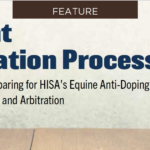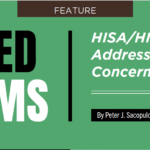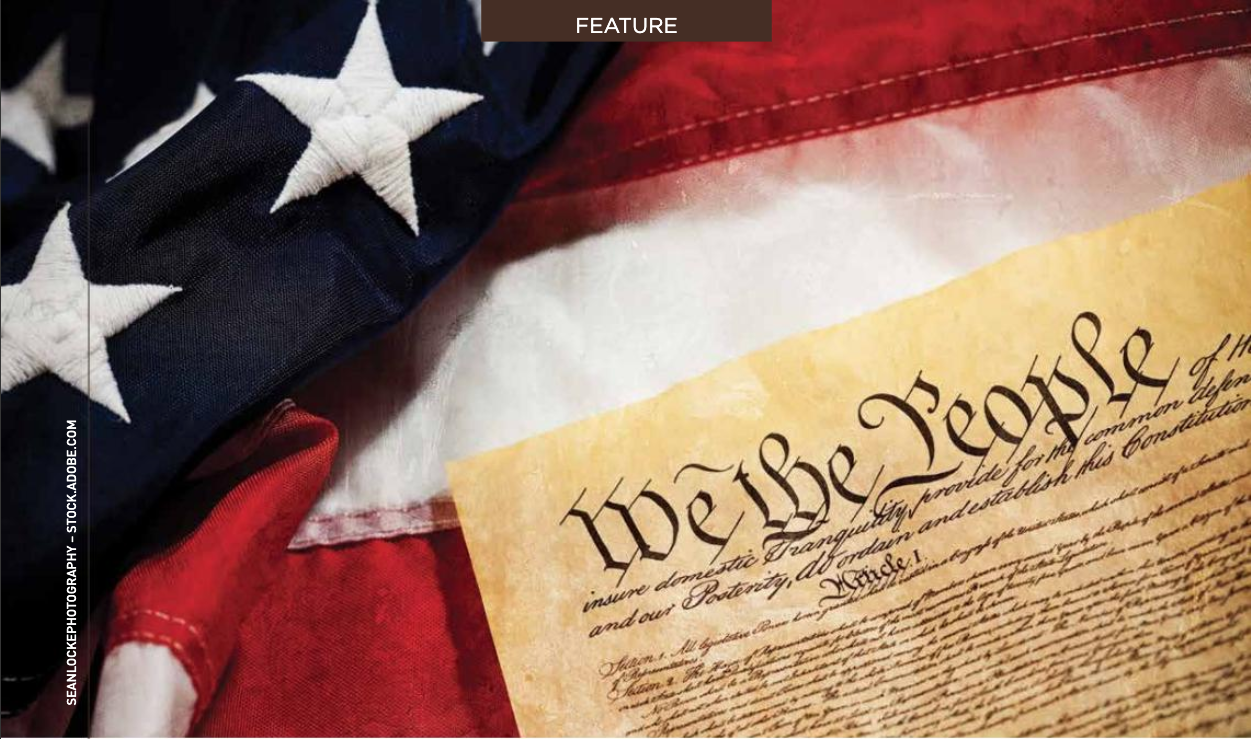Written by Peter J. Sacopulos, JS. Originally posted on: The Horsemen’s Journal – Spring 2021
On December 27, 2020, President Donald J. Trump signed into law the COVID-19 relief package. Among the 5,593 pages of that package was the Horseracing Integrity and Safety Act.
For nearly a decade there have been efforts to bring uniformity to racing. Proponents of national legislation maintain that uniformity of rules among the 38 racing jurisdictions is needed, especially when it comes to the establishment and enforcement of medication rules. The first major attempt at such national legislation was introduced May 4, 2011, by Sen. Tom Udall (D-NM). That bill, the Interstate Horseracing Improvement Act, was introduced to amend the Interstate Horseracing Act of 1978. The bill was not successful. Then, in 2015, Rep. Andy Barr (R-KY) and Rep. Paul Tonko (D-NY) introduced the Thoroughbred Horseracing Integrity Act, commonly referred to as the Barr-Tonko bill. It too was unsuccessful. That same year, the Horseracing Integrity and Safety Act was introduced by Rep. Joe Pitts (R-PA) and failed to pass. Thereafter, Barr and Tonko introduced the Horseracing Integrity Act of 2017, which also failed to pass.
Fast forward to 2020, when Barr and Tonko introduced an updated Horseracing Integrity and Safety Act. This time, the political climate was different. A series of highly publicized breakdowns of Santa Anita followed by a federal investigation and resulting indictments of prominent trainers and veterinarians in the sport sparked a renewed call and added support for federal regulation of the sport. On September 29, 2020 the Horseracing Integrity and Safety Act was passed in the U.S. House of Representatives. There was another difference in 2020. Proponents of federal legislation had persuaded Sen. Mitch McConnell (R-KY) to not only support but also to introduce corresponding legislation in the U.S. Senate. Then, on December 27, 2020, President Donald J. Trump signed into law the COVID-19 relief package. Among the 5,593 pages of that package was the Horseracing Integrity and Safety Act (HISA). Federal regulation of horse racing, at least for Thoroughbred horse racing, had arrived.
When the bill was signed into law, it was a day of celebration for some but not certainly not all. Supporters of HISA include, among others, The Jockey Club and members of the Water Hay Oats Alliance, but there were and remain those opposed to HISA. Major associations and representative groups worked in opposition to this legislation. Those groups and organizations include the National Horsemen’s Benevolent and Protective Association and the National Association of Racetrack Veterinarians.
Opponents of HISA take issue with the limitation and ultimate elimination of Lasix. Funding of this new federal scheme governing medication and track safety violations has many industry participants concerned they will be footing the bill for the new system in an industry that is already financially challenged. Turn to page 35 of this issue for a detailed analysis of those issues. Additionally, there are serious constitutional questions regarding HISA.
First, HISA violates Article 1, Section 1, of the U.S. Constitution, specifically the non-delegation doctrine, which provides that Congress is prevented from deleting legislative authority to any other entity.
Second, HISA violates the due process clause, which prohibits an economically self-interested private actor from wielding regulatory power over private parties. Third, HISA violates Article 2, Section 2, of the Constitution because it violated the appointments clause that required appointments to public agencies to be made only by the executive branch. Fourth, HISA violates rules prohibiting anti-commandeering. The U.S. Supreme Court has held that Congress “… not commandeer the state’s offices or those of their political subdivisions to administer or to enforce a federal regulatory program.
The first constitutional challenge to HISA has been filed. On March 15, 2021, less then 100 days after HISA was signed into law, a group of representative associations formally challenged the Horseracing Integrity and Safety Act. The party plaintiff include the National BHPA and its affiliate organizations in Arizona, Arkansas, Indiana, Illinois, Louisiana, Nebraska, Oklahoma, Oregon, Pennsylvania and Washington. Also joining in as a plaintiff is the Mountaineer Park HBPA. Their challenge seeks declaratory and injunctive relief. This cause of action names as defendants the seven members of the Nominating Committee for the Horseracing Integrity and Safety Act: Jerry Black, Katrina Adams, Leonard Coleman Jr., Nancy Cox, Joseph Dunford, Frank Keating and Kenneth Schanzer. Also named as defendants are the Horseracing Integrity and Safety Authority Inc., the Federal Trade Commission, the acting chair of the Federal Trade Commission and the Three Federal Trade Commissioners.
This claim has been filed in the U.S. District Court for the Northern District of Texas. The plaintiff seek an order declaring that HISA delegates legislative authority to the Horseracing Integrity and Safety Act Authority in violation of the non-delegation doctrine and that HISA violates the appointments clause. Further, their action seeks a ruling and finding that HISA violates the due process clause because it provides economically self-interested actors with the power to regulate their competitors. Finally, the plaintiff, by way of their complaint, seek a court order enjoining or prohibiting the defendants from taking any action to implement the Horseracing Integrity and Safety Act of 2020. See page 12 of this issue for a news release regarding the lawsuit.
The constitutional issues surrounding HISA are of concern to me as a practicing lawyer representing licensees before state commissions and regulators. So too is a section of HISA that has received limited attention, review or analysis. That is Section 1209.
Section 1209 of the legislation, which is titled “Review of Final Decisions of the Authority,” sets forth the disciplinary process. In most jurisdictions, a person faced with an alleged medication or track safety violation is afforded an opportunity to be heard through an administrative law process and, thereafter, a judicial process. Specifically, in most jurisdictions, the licensee accused of violating a medication or safety rule or regulation is first provided the opportunity to present a response to the stewards at a stewards’ hearing. If the stewards’ ruling is not favorable, the licensee may appeal that decision. The appeal of the stewards’ ruling is typically conducted by a state regulatory agency’s appointed administrative law judge (ALJ). The ALJ conducts a hearing on the merits and, in doing so, received testimony and evidence from both the petitioner and the respondent. At the conclusion of the merits hearing, the ALJ issues finding of fact, conclusions of law and a recommendation for a penalty or for no penalty. The petitioner and/or the respondent may then appeal the ALJ’s recommendation to the state commission for final administrative review. The ruling of the state commission, which in most jurisdictions constitutes the final stage of the administrative process, also may be appealed in a timely manner. It is at this juncture that the resolution process shifts from an administrative proceeding to a judicial proceeding via the filing of a petition for judicial review. Section 1209 presents a significant departure from the current system.
The process for review set forth in Section 1209 begins with the Horseracing Integrity and Safety Authority (Authority). HISA defines the Authority as a private, independent and self-regulated nonprofit corporation composted of nine members. Upon the Authority identifying a medication or safety violation, an investigation is commenced. If the Authority concludes a violation has occurred, it determines sanctions and, in doing so, files notice of the sanctions with the Federal Trade Commission (FTC). It is unclear whether these since members will sit in judgment as the Authority for the initial stage fo an alleged violation or whether a subcommittee of the Authority will do so. Section 1209 is equally unclear as to whether the proceeding before the Authority is considered a hearing on the merits. This is important to horsemen with regard to establishing the record of proceedings should the matter be appealed. What is clear is that the Authority replaces the current stewards’ hearing in the present context of state commission proceedings.
Section 1209 does provide for the right to appeal a noticed civil sanction by the Authority. Within 30 days of the notice of sanction being filed by the Authority, the sanctioned party may file an application for review of the Authority’s decision. If an appeal is taken, the dispute is submitted to an ALJ for de novo review. This means the ALJ considers testimony and evidence and renders a recommendation without deference to the Authority’s prior decision. The ALJ may affirm, reverse, modify, set aside or remand the notice of sanction for further proceedings.
Pursuant to Section 1208 of HISA, the ALJs are to be “impartial hearing officers.” However, based on the legislative history of HISA, it appears the ALJs will be employees or agents of the FTC. This is significant to horsemen because the ALJ that conducts the merit hearing and rules on the admissibility of evidence and testimony will apparently be an employee of the FTC. In short, one side selects, appoints and pays the ALJ. It is the side that employs the ALJ. It is not the horseman (or “covered persons,” as defined by HISA), and this system is difficult, at best, to square with this legislation that contains a specific “conflict of interest” provision, that being Section 1203(E).
The Authority or the covered person, if dissatisfied with the ALJ’s findings of fact, conclusions of law and recommendation, may then file an application for review with the FTC, which may accept or deny the application for review (appeal). Should the FTC refuse an application for review, the ALJ’s findings of fact, conclusions of law and recommendation consist ute the FTC’s decision and is appealable to the U.S. Court of Appeals. Should the FTC accept an application for review and issue a ruling in connection with that application, that ruling is, likewise, appealable to the U.S. Courts of Appeals.
Title 5, Chapter 7, of the United States Code provides for judicial review of agency action. Similar to a party petitioning for judicial review of a state agency’s decision before a state court, 5 USC 702 titled “Right of Review” provides that “a person suffering legal wrong because of agency action, or adversely affected or aggrieved by agency action within the meaning of a relevant statute, is entitled to judicial review thereof …” The scope of review set forth in 5 USC 706 is also similar to a petition for judicial review before a state court. This means the federal court will not retry the case in the merits. Instead, as is the case in most state court proceedings involving a petition seeking review of an agency’s final order, the federal court’s authority in reviewing a final order of the FTC is limited to:
- “. . . compel agency action unlawfully withheld or unreasonably delayed; and
- hold unlawful and set aside agency action, findings and conclusions to be found to be —(A) arbitrary, capricious, an abuse of discretion or otherwise not in accordance with law;(B) contrary to constitutional right, power, privilege or immunity;(C) in excess of statutory jurisdiction, authority or limitations, or short of statutory right;(D) without observance of procedure required by law;(E) unsupported by substantial evidence in a case subject to section 556 and 557 of this title … or otherwise reviewed on the record of an agency hearing provided by statute; or(F) unwarranted by the facts to the extent that the facts are subject to trial de novo by the reviewing court . . .”
Also similar to state court proceedings, parties subject to a decision of the U.S. Court of Appeals to have the right to appeal that decision in a timely manner to the U.S. Supreme Court.
Section 1209 of HISA is of further concern because it creates a redundancy regarding the review process. HISA provides that the Authority will sit in review of all alleged medication and safety violations. However, non-medication and non-safety violations will continue to be regulated, reviewed and enforced by state regulators/agencies. In short, there will be two parallel review and enforcement systems. Unclear is whether proceedings before the Authority will be governed by the Federal Code of Regulations, Administrative Procedures Act, provisions of state or federal law or by combination of some of all of these rules and regulations. This is significant because licensees or “covered persons” may face a review before a state agency for an alleged non-medical or track safety violation governed by state and administrative law and a review before the separate Authority for connected or corresponding alleged medication or safety violations utilizing some, but not all, of the corresponding rules and regulations. These two parallel systems with similarities and dissimilarities result in redundancy and additional expense to all involved. To be clear, HISA does not replace the entire review and enforcement function of the state commission.
Uniformity in establishing and enforcing medical rules is needed. So too is uniformity and consistency in testing laboratories. HISA addresses these issues and is a positive step in these areas. However, from the horsemen’s and participants’ perspective, there is concern and need for reform. The constitutional challenges presented by the National HBPA and its affiliates are the beginning of the challenges HISA will face. Funding issues, including fees to be collected by state agencies and, ultimately, from taxpayers to fund HISA, will provide further fodder for dispute. So too will disputes over rule making and enforcement of therapeutic medications and a review process that may result in redundant, parallel systems of resolution. All of these issues demand, merit and deserve discussion and reform. Hopefully, that discussion will be industry-side, inclusive process. Absent such as approach, HISA will continue to face series challenges, some of which will very likely lead to it being deemed unconstitutional and/or unenforceable, in whole or in part. HJ
Peter Sacopulos is a pattern in the law firm of Sacopulos, Johnson and Sacopulos, in Terre Haute, Indiana. He is licensed in Indiana and Illinois and his practice includes representing clients in administrative hearings and in matters of general equine law. He serves on the board and is an officer of the Indiana Thoroughbred Owners and Breeders Association, and he is national legal consultant to the North American Association of Racetrack Veterinarians. Sacopulos has written extensively on equine law issues, including for North American Trainer, The Horsemen’s Journal, Equus, Equestrian Professional Newsletter and the Kentucky Journal of Equine, Agriculture and National Resources Law. He is a frequent speaker at equine conferences and has presented at the National Equine Law Seminar in Lexington, Kentucky, and the Saratoga Institute on Equine Racing and Gaming in Saratoga, New York. Sacopulos received a B.A., cum laude, from Tulane University and a J.D. from Indiana University School of Law.






